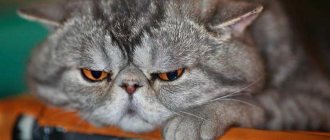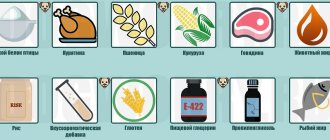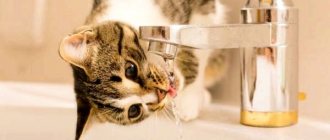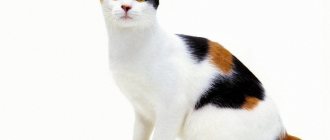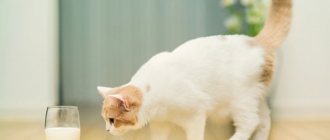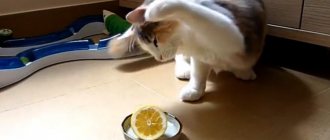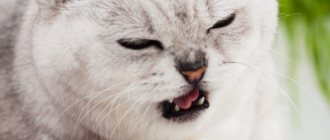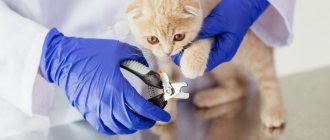3966Pavel
1
Massage has long been known for its healing properties. It can relieve pain, help you relax, and even promote faster healing. The massage therapist must act carefully and correctly for it to truly bring benefits. The article will not only tell you how to massage a cat, but also tell you why and when to do it. Pleasant stroking and pressing will calm you down during a trip or upon returning home, strengthen the bond between pet and owner, and help you survive unpleasant procedures. Aging cats, whose muscles and bones can ache from age and overload, especially love massage. It will remind little kittens of their mother.
Buy your cat a puzzle
Mal Mower/BuzzFeed, amazon.com
Cats love riddles, which is probably why these animals themselves are so mysterious. That's why it's so important for our purring friends to purchase the right toys, like the one you see in the gif above.
Simple design, but so much functionality. Throw down a ball, ball or other ringing, glowing toy - and consider that your pet is busy for the next hour. He will need a lot of ingenuity to figure out how to get all these items out of there.
Boxes and bags
These things cause indescribable delight in cats. Animals are willing to spend a lot of time studying:
- how the object is structured from the inside, what it smells and tastes like;
- what it is made of and how durable it is;
- why does it rustle and is it suitable as a house or shelter.
Having discovered that an object can be bitten and scratched, cats become so carried away that they can tear the toy to pieces.
Important! Make sure that in the heat of excitement your pet does not eat cardboard and cellophane.
The box was found - life was good!
Get a drinking fountain for cats
Amazon
If you have noticed that your cat constantly strives to drink water straight from the tap, you are witnessing another strong natural instinct of cats. In the wild, running water is clean and safe to drink (there are exceptions, but these are just coincidences).
For this reason, to make life more comfortable for your mustachioed companion, grab a drinking fountain and see what happens.
Relaxation massage technique
You need to start the massage with circular movements along the spine.
With light, pleasant movements, you need to move in a spiral, massaging only with your fingertips. First the movements go clockwise, then counterclockwise. Gradually you need to increase the intensity of the pressure, depending on the pet’s behavior. The procedure is repeated up to 4 times.
Cats, like humans, also have acupuncture points that are connected to many organs. Exposure to them activates the work of these organs and the mechanism of action of protective forces is activated. From the back of the head to the sacrum you need to apply pressure with your thumbs.
Next, you can massage the head, starting from the base of the skull. Massage is performed with light circular movements of the fingertips. Gradually the pressure increases. Stroking and pressing should be pleasant, they will make the cat relax and go limp. Now you can move on to massaging the front side of the neck, but the area of the pharynx and trachea should not be touched. In those places where the lymph nodes are located, you also need to massage with caution, avoiding strong pressure.
It is recommended to have a couple of trays for cats in a large apartment
Mal Mower/BuzzFeed
They say that there should be one main tray for a cat and one additional one, especially if there are several cats in the apartment. This is supposed to keep them from showing dominance (cats won't pee past it, showing their rival that it's their property) and vandalism from an angry animal. The upholstery and floors will thank you later.
Contraindications for carrying out
Despite the undeniable benefits of massage, in some cases it still cannot be done. Let's look at exactly what cases.
- If the cat has just been injured or seriously damaged. In this case, with dislocations and fractures, the help of a veterinarian is needed. If a bruise occurs, the cat needs to be given time to rest. Perhaps apply cold to the sore spot.
- You cannot do massage for viral diseases that occur in acute form.
- When there is a high temperature. In cats it is higher than in humans, but the mark of 39.5 ◦C can already be considered critical. In this case, you will need the help of a doctor.
- In the presence of cancer. In this case, the spread of neoplasms can be provoked.
- If there is a violation of the skin: dermatitis, wounds, ulcers, tumors.
- If the venous walls are enlarged, it is also better to avoid the massage procedure.
- If your pet's skin is affected by a fungal disease.
- In case of arthritis in the acute phase, massage cannot be performed, as this can provoke an increase in the inflammatory process.
Using hidden trays
Mal Mower/BuzzFeed
The advice is quite strange, but we’ll voice it too - maybe it will be useful to someone. So: it is advised to use “secluded trays”, hidden from prying eyes. For example, this one: a girl sits and smiles, not knowing that she is sitting, in fact, on a cat's litter box.
As an experienced cat lover, it is not clear to me how the owner combats the smell in the hallway. Even if you quickly clean everything up, the smell will still remain, and not in the restroom, but, in fact, in the living room. Not a very pleasant neighborhood...
Massage for kittens
The difficulty of massage for a kitten is to try to extend the procedure over time, because the baby constantly tries to slip out of your hands. This little bundle has so much energy that it’s not always possible to pet it.
Find a time when the kitten is not in the mood for games, but in the desire to sleep. Start from the back, stroking and slightly stretching it along the sides of the entire body from the neck to the tail. Using circular movements, massage your shoulders, shoulder blades and thighs.
Turn your little bundle of joy over to massage your chest and tummy. A kitten needs belly rubs for proper digestion and to avoid problems with the toilet. Walk along the inside of your neck. Iron all the fur on the face and scratch the forehead with your fingers. This procedure helps build trust between the little fidget and its owner, because the kitten still remembers the gentle touches of its mother.
Remove everything unnecessary from the table
NBC television company
Or your cat will do everything for you! It is almost impossible to train your four-legged friend not to jump on the table. Even if he does not break the established rules in front of you, when you are not looking, it is quite possible that he will wander around the tables. And if he gets his hands on something interesting, he will definitely try to throw it off.
What does treatment include?
The first thing you need to do to help an animal in case of coprostasis is not to feed it for a couple of days. Don’t be afraid, during this time nothing will happen to the animal without food, and this measure will reduce the load on the intestines.
With the drinking regime, the opposite is true - the cat needs to drink a lot. If your pet refuses water, give it water from a syringe without a needle. You can significantly alleviate a cat's suffering from constipation by giving her a massage.
Remember that you should never use a laxative without a veterinarian's prescription. If there is an inflammatory process in the body, taking the drug will only worsen the situation.
Indications and benefits
To solve the problem of constipation, it is recommended to consult a specialist to rule out other diseases of the gastrointestinal tract. Veterinarians may recommend drug treatment with laxatives to restore normal intestinal motility, and prebiotic/probiotic agents to improve microflora. At the same time, the doctor prescribes an enema and massage.
Massaging your cat's belly is a very effective non-drug remedy for constipation. When stroking, peristalsis increases, natural movement of feces occurs through the intestines, and, as a result, the cat begins to go to the toilet normally.
Pros of massage:
- very easy to do at home;
- does not require special skills;
- Suitable for pets of any age and gender;
- so effective that you can do without toxic medications.
However, in some cases, massage for constipation is contraindicated - this point should be clarified with your veterinarian.
Contraindications
Before giving a massage to a cat with constipation, it is worth ruling out intestinal volvulus and colitis. If you ignore the recommendation, instead of alleviating symptoms, you can achieve the opposite effect. For example, if constipation is caused by colitis, the pain will only get worse. With intestinal volvulus, massage is simply useless.
If the animal suffers from dermatological diseases, which include injuries, eczema, burns, etc., the procedure should also be abandoned. If your pet has exhaustion or inflammation of internal organs, massage will only do harm.
You should not give massage to pregnant cats and those who underwent abdominal surgery or pelvic trauma less than six months ago.
Try to avoid citrus scents in your home
Martin Poole/Getty Images
Cats hate the smell of citrus fruits. This may be an excellent option for keeping your cat away from the sofa or other piece of furniture that he is partial to for some reason, but still try not to spread the smell of citrus fruits throughout the apartment. Otherwise, the green-eyed monster will start hating you 24/7.
What diseases require massage?
Often massage is prescribed as a rehabilitation tool after suffering or during one of the following diseases:
- closed injuries. Including bruises, dislocations of joints: hip and knee;
- neuritis (occurs due to inflammatory diseases of the peripheral nerves); they are often accompanied by pain and cause a lot of suffering to pets;
- swelling of the limbs;
- arthritis and arthrosis, common diseases in cats. Pets are especially susceptible to them; they are fed by loving owners, and the pets themselves move little. In this case, inflammation of the synovial membrane occurs in the joints. With arthrosis, the joints slowly deteriorate;
- after operations, for quick recovery.
If your cat is curious and not afraid, take her for a walk
Mal Mower/BuzzFeed
This is not for every cat, but if you see that the kitten is brave and not afraid of strangers, it might be worth a try. It is clear that the cat must be on a leash (so as not to run away: the city is full of irritants that frighten animals), and not just on a leash, but on a harness - a special harness for cats that will not damage its neck or cause discomfort.
It is naturally better to walk in the park, on the grass or in the forest, if they are nearby. Before walks, it is necessary to have all vaccinations for walking cats (vaccination against panleukopenia viruses, herpesvirus (viral rhinotracheitis), calicivirus and rabies, and others, if necessary), as well as courses against the appearance of worms.
At the dacha, the cat is more at ease; there you can do without harnesses. Cats are very smart and have excellent spatial awareness. It is unlikely that your pet will get lost or disappear, even if it jumps over a fence. But it’s better to make sure that the cat walks only on its six hundred square meters. This way, risks are minimized, and all that remains is a good mood, exercise and health for the pet.
How to give a cat massage
Massage for a cat is not as easy a procedure as it might initially seem. To figure out how best to massage your cat and perform this procedure well, use our tips.
Your pet must trust you
Keeping your cat comfortable
- Let the kitten get comfortable.
You should not start doing massages on the same day that the cat appears in your family. Let him get to know you and the environment better, build a trusting relationship. Through your attention, affection and encouragement, this process will be short-lived.
- Find the right time.
A cat who is feeling tired, angry or irritated is not in the mood for affection. He will be even more angry from your actions and attempts to restrain him. A hungry cat will also not want to be stroked, but a cat that has just eaten food needs rest. The most natural period for rubbing is when the cat himself comes to you to relax together.
Take advantage of the moment when the cat lies down in your arms
But you should also be in harmony during the period of stimulation. Try to mentally get rid of all irritating factors, fatigue, apathy. Think only about the procedure and how important it is for your beloved Murka.
- Take your wishes into account.
Each animal has its own sensitive areas, which it actively protects from the touch of others. This could be the tail, rump, head or belly. You should completely ignore these areas or massage them more carefully if your mustachioed friend allows it. Listen to the sensations, massage more actively where it is pleasant, do not touch where it hurts.
Purring, closed eyes and a relaxed body indicate that the animal is completely delighted.
- Talk to the cat.
A detail such as a conversation will create even more trust and goodwill between you. You need to talk to the kitten as if you were reading a fairy tale, and your voice should be quiet and your tone low. Say the animal's name several times. His devotion to you will increase significantly.
- Don't overdo it.
The benefit of the procedure is its regularity, not its duration. If you make it a rule to devote at least five minutes every day to your cat, it will be better than massaging it for 40 minutes after reading the article, and forgetting about everything tomorrow.
Massage technique
Like a real massage therapist, start with the areas that your kitty likes to massage most. Stroke slowly, allowing her to relax into a comfortable position. If she purrs, it means she asks you not to stop.
Start massaging from the most pleasant places for your cat
Be careful if your cat is pregnant. Do not use kneading or pinching movements. Massage your head, neck and gently stroke your back. If your cat trusts you, she will allow you to pet her belly. But do it without pressure. When stroking, use your fingertips or the inside of your hand.
Take your time. A massage for a cat is needed for relaxation. You can use vigorous movements, but slow rubbing will benefit the most. In general, trust your pet’s intuition and reaction to your actions.
If the cat resists and tries to escape at the first opportunity, there is no need to insist. Let him go and wait for a more appropriate time.
Cat head and neck massage
Surely your pet loves to scratch its neck under its chin. When giving your cat a head massage, start with the neck. This will encourage the animal to take further action.
Many cats like neck massages
Smoothly move to the head to the area of the so-called “antennas” - the place on the forehead where the letter M is located (in tabby cats it is especially clearly visible). Massage your forehead with the pads of your four fingers, then move in a circular motion over your entire head. Gently walk your fingers along the temples and behind the ears.
Kitten with the letter M on its forehead
Try stroking the cheeks, starting from the middle of the jaw and upward, as animals usually do when they rub their faces on furniture. Press a little harder. If the cat is relaxed, she will allow you to rub the bridge of her nose and eyebrows. From the head, move towards the withers area and remember the neck at the base of the head, there is a large plexus of nerves that needs to be massaged. Use a pinching motion, bringing the four fingers of your hand together with your thumb. Then proceed to massage movements of the body.
How to massage the body
Using light, slow pressure, walk along the cat's back from head to tail. Look at the animal's reaction and repeat several times if the cat likes it.
Repeat the movements on the back 8-10 times.
Move to the shoulders, massage the area of the shoulder blades in a circular motion, moving down to the elbow. It is advisable not to touch the area below the elbow at the first stage, as the pet may not like it. Wrap your hands around your chest and massage the entire chest area. This can be done while the cat is sitting on its paws. If your friend trusts you and seems to be asking you to continue, you can turn him over on his back, placing him comfortably on your lap.
Using pinching and circular movements, massage the cat's shoulders and hips.
Depending on the sensitivity of the cat, gently stroke the tummy, stretch the body with your hands, starting from the chest and to the hind legs. Finish the cat's paw massage if your pet doesn't mind. Using your thumb, massage each footpad for 30 seconds.
Devices such as brushes and massage mittens can be used by you during the procedure, but nothing can replace direct tactile contact.
The paws are quite sensitive, and the cat does not always allow you to touch them. So save them for last.
A cat must have a shelter, and more than one
Unsplash.com
Cats consider the entire apartment to be their territory. If strangers come (your friends whom the cat has not seen before), most cats are frightened by uninvited guests, treat them with caution and try in every possible way to hide from them.
They hide anywhere in secluded places: under the bed, behind a thick curtain, under the bathroom, they crawl into any cracks and sometimes try to get into places where it is physically impossible to squeeze in. Give them this chance!
Games on the tablet
Modern cats are no strangers to intellectual entertainment in the form of programs on gadgets. To make sure, you can download one of the following to your Android tablet.
Cat Toy For Tablets & Phones Program
The application contains games designed exclusively for cats. If you wish, you can hunt for:
- a mouse that is very similar to a living one;
- black;
- teasing laser beam.
At the same time, you are allowed to change the background and choose the soundtrack. The fun is simple, but despite this, it can captivate the cat for a long time, and give the owner a reason to be touched by the pet’s behavior.
Screen with Cat Toy For Tablets & Phones
Cat Alone Program
Its principle is the same: the animal tries to catch objects that move on the monitor. The following can act as bait:
- insects;
- finger;
- strange scribbles.
The program developers are sure that the cat will certainly like the game, and to make sure this happens, they have released options where you can hunt for mice, fluffy feathers and dandelions.
Screen with Cat Alone
Crazy Cat program
This application differs from others in that it allows you to have fun together with the owner. You will need a phone connected to the tablet via Bluetooth. The person controls the activity of the characters whose images the cat will catch on the monitor. For each success, players receive points. At the end of the game, it will become clear which player has a better visual perception speed and reaction: the owner or the pet.
An activity to your liking
Happy Wings Program
Insects and funny birds fly on the tablet screen. The cat will definitely want to catch it. If successful, the entertainment goes to a new level, so your pet will never get bored.
Happy Wings screen
Game for Cats Paw Me program
Universal fun that is interesting to cats, as well as birds, domestic dogs and even iguana lizards. The meaning of the game is the same: you need to catch bows, fish and mice flashing on the screen. Background screensavers change, animation is included, so the process is captivating. Among other things, you can arrange fights like “cat versus cat” or “cat versus owner.” The disadvantage of such toys is that pets have not yet learned to turn on tablets on their own.
Screen saver Game for Cats Paw Me
Cats are allergic
Margarita Khamidulina/Getty Images
Cats can have persistent allergies to flowers, plants and fruits. To know what your four-legged friend can sneeze on, follow the following link and, by translating the site using the translator built into your browser, read which plants can be dangerous or harmful to your cat: www.aspca.org
To detoxify, don't forget to purchase cat grass. It is also useful for removing hair and other impurities from the cat's stomach.
What you need to pay special attention to
Even the most professional massage for a cat can result in snorting and attempts to escape. Therefore, you must always listen to the animal’s mood. Attempts to get up, leave, grumbling signal an unwillingness to endure the procedure, while sharp twitching, screams and moans indicate that there is a problem and help is needed. If you suspect a reaction of pain in the cat's body, you need to immediately interrupt the massage, remember the problem area and monitor the cat's behavior. If possible, inspect it for scratches, bumps and injuries.
The desire to give your animal a massage is an excellent reason to examine your pet’s fur and skin. The fur should be dry, pleasant to the touch, without lumps or dirt. The skin should be free of bumps, bite marks and irritation.
Pet your cat only where she allows it.
For cats, where you pet her is a very important factor. If you constantly want to stroke her belly, but she doesn’t give it, it definitely won’t add love to you. If your pet wants this, he will lie down on his stomach.
Start with a light massage of the cheeks and neck. If the cat likes it, it will begin to purr, squint and lightly move its paws. If you pet in an inappropriate place, the cat will begin to wag its tail and become a little tense.
Remember: each animal's g-points are different. But if you find them in your cat, long and sincere love is guaranteed.
Exquisite cake with geometric design: sponge cake and raspberry jelly inside
The couple has found the perfect way to avoid the virus: they live on an island without neighbors
Mr. Bean has been making fun since 1990. However, Rowan Atkinson is unhappy with his role
Indications for massage procedures
The kitten feels the beneficial effects of massage movements from birth; postpartum licking by a cat tones the baby, stimulates processes in the body, and encourages action. Regular massaging of the abdomen is necessary for the baby's digestion. Massage of the tummy and body is mandatory for kittens left without a mother.
Old animals also need additional stress and exercise. Kneading exercises improve the quality and duration of their life, relieve pain, and stimulate the functioning of the kidneys and intestines.
Very active and sedentary animals benefit from massage to normalize muscle tone.
Massage is especially indicated for conditions such as:
- paralysis and paresis after falls and accidents;
- injuries (rehabilitation);
- some congenital and genetic diseases;
- restriction of movements for a long time for various reasons;
- joint dysplasia in large breeds of cats.
Massage techniques
When massaging a cat's hind legs, all five basic techniques are used:
- Stroking.
Performed in the direction of hair growth, hands easily, without pressing, rhythmically glide over the skin. The treatment has a superficial effect, is used as a relaxant and cleanses the skin of dead cells and sebaceous gland secretions. - Trituration.
The fingers move in the same way as when stroking, but do not slide over the skin, but move it, providing a deeper impact. Reception helps improve blood circulation and increase turgor of muscles and blood vessels. - Kneading.
This technique takes up most of the massage time; it ensures the development of the subcutaneous layers and muscles. It is performed with the tips of the fingers and the upper part of the palm: the fingers grasp, lift and shift the skin-muscular fold, then with the edge of the palm it is pressed against the bones of the joint. - Vibration.
This massage technique has an effect on deep-lying muscle tissue, blood vessels, nerve endings and internal organs. It is performed with the fingertips of one or both hands: without leaving the surface of the skin, the fingers make rhythmic oscillatory movements. - Effleurage.
Stimulates blood flow, causes muscle contractions, and has a positive effect on the nervous system. The technique is performed as follows: with bent fingers or the edge of the palm, quickly but lightly tap the surface of the hind paw, avoiding the areas where the joints are located.
For what reason did the cat's hind legs fail and what to do about it?
Sometimes pet lovers are faced with the following situation: a cat’s back legs have failed. Paralysis or paresis of the limbs is a neurological symptom of serious pathologies of the body. The list of them is very diverse and affects a variety of organs and systems. In the early stages, this condition may be reversible. Therefore, if a cat drags its paw, early contact with a veterinarian significantly increases the likelihood of recovery. One can hope that over time the animal will again feel the joy of movement. From this article you will learn what to do if your pet loses its hind legs, why this can happen and how to help your cat at home.
The importance of differential diagnosis
If a cat's hind legs fail, it is quite difficult to find out the reasons for this. There is a belief that almost all diseases can cause complications and forced limitation of movement.
If a cat does not walk, it can be difficult to distinguish between paralysis of the paws and severe pain that occurs when moving. Perhaps he, experiencing pain when walking, simply refuses to make efforts, since they bring additional discomfort. The causes of severe pain in the back or abdominal area may be the following ailments:
- urolithiasis disease; tumor diseases; inflammation of the urinary and reproductive system; intestinal obstruction.
A distinctive feature of these diseases is that the cat’s paws retain full sensitivity and nerve conduction is not impaired.
The main causes of the disease
The main causes of partial or complete paralysis of the hind legs are the following pathologies:
- consequences of spinal injuries and traumatic spinal cord injuries; intervertebral disc prolapse; inflammatory diseases of the spinal cord; arterial thromboembolism; fibrocartilaginous embolism; vitamin deficiency and potassium metabolism disorders; hip dysplasia; cardiomyopathy and fibrosis of the heart muscle; consequences of stroke; nutritional hyperthyroidism; consequences of ixodid tick bites.
Consequences of spine and spinal cord injuries
When a cat has a fracture, dislocation of the spine, or severe contusion of the spinal cord, a post-traumatic reaction often occurs - the hind legs are taken away. Paw paralysis may be accompanied by painful shock, loss of consciousness, and fecal and urinary incontinence. With proper treatment and the absence of complications, the animal’s condition is usually reversible and after restoration of nerve conduction, sensitivity gradually returns.
Such serious pathologies are treated in most cases in the clinic surgically. Additionally, the doctor prescribes anti-inflammatory, healing and painkillers (Traumel, Milgamma, Baralgin).
Herniated disc
A herniated disc is a protrusion of a disc between the vertebral bodies. Characterized by pain, muscle tension and limited movement. In severe cases, a herniated disc can cause compression of blood vessels, nerve roots and the spinal cord, in which conductivity gradually deteriorates. Because of this, the innervation of the limbs is disrupted, and they can become paralyzed.
If a cat's legs are paralyzed due to this disease, then painkillers, muscle relaxants that relieve severe muscle spasms, decongestants, and vitamins that improve the condition of nerve fibers are prescribed as treatment.
Spinal cord inflammation
The cause of inflammation of the spinal cord (myelitis) can be injuries, complications of infections, helminthic infestations, and poisoning with toxic substances. Such pathologies are usually accompanied by gastrointestinal disorders, severe fever, feelings of anxiety and fear, nausea and vomiting. In addition, the cat's hind legs gradually fail. With myelitis, the condition is usually reversible and after the inflammation is relieved, the animal's limbs regain sensitivity over time.
Treatment consists of prescribing antibiotics, anti-inflammatory drugs, and muscle relaxants. Physiotherapeutic procedures have a good effect.
Arterial thromboembolism
Arterial thromboembolism of the femoral artery is a blockage of the artery by an embolus (a foreign particle circulating through the bloodstream). An embolus can be a particle of clotted blood (thrombus), a parasite, or a piece of tumor. Thromboembolism disrupts the blood circulation in the paws.
The cat does not feel the bloodless limbs; they gradually become cold. The animal screams in pain, refuses to eat and drink, and prefers to be in dark places. The disease often has a poor prognosis, since the likelihood of cure is very low. But in rare cases, with early diagnosis and proper treatment, the disease recedes.
If sensitivity is at least slightly preserved and there is hope, then the animal is given a paw massage, anticoagulants (reducing blood clotting) and physiotherapeutic procedures are prescribed.
Fibrocartilaginous embolism
With fibrocartilaginous embolism, a thrombus clogs the vessels of the spinal cord. Bleeding tissues gradually become necrotic. Severe pain is replaced by a complete lack of sensitivity. Subsequently, the cat's front and hind legs fail. If the blockage of the vessel is incomplete, then the paralysis of the limbs will be partial and then a cure is possible. The main treatment tactics are the prescription of anticoagulants and physical therapy.
Vitamin deficiency and potassium metabolism disorders
A lack of vitamins and minerals in the body that affect the condition of the limbs and their functions can cause paralysis or paresis of the paws. The probable cause of vitamin deficiency is helminthiasis or a poor cat diet. A lack of vitamins A and B1 is especially dangerous. Lack of sunlight can lead to vitamin D deficiency and, as a result, rickets, which is more common in kittens. With paresis, a lack of potassium in the body is often diagnosed.
Vitamin deficiency and micronutrient deficiency can be easily eliminated. After deworming, restoration of a nutritious diet and a course of vitamin therapy, the cat will regain the ability to move independently.
Hip dysplasia
Hip dysplasia is a congenital pathology of the development of the joint, which greatly increases the likelihood of subluxation and dislocation of the femoral head. The disease develops as a result of genetic predisposition or intrauterine developmental defects. Young animals are more susceptible to it. There is also a breed predisposition (Maine Coon cats are more often affected).
This disease is not associated with loss of sensation and paralysis. The animal cannot walk due to a joint malformation. The main symptoms of the disease are:
- limb weakness; inability to jump; tilting to the side of the affected joint, frequent falls; unsteady gait.
The therapy consists of limiting the cat's movement in order to reduce the load on the sore paws and prescribing special food containing glucosamine and chondroetin, as a building material for the cartilage tissue of the joints.
Cardiomyopathy and fibrosis of the heart muscle
Cardiomyopathy is a group of myocardial diseases caused by dystrophic and sclerotic changes in cardiac cells - cardiomyocytes. It often leads to thickening of the heart walls and decreased volume of the ventricles, causing the heart to pump less blood. The animal begins to suffer from oxygen starvation. Main symptoms:
- dyspnea; decreased physical activity; cough and vomiting; refusal to eat.
Paralysis of the hind legs is not typical for cardiomyopathy, but as a secondary disease, thromboembolism can develop, which is the direct cause of paralysis. In addition, the cat is often unable to move due to severe weakness.
Cardiomyopathy can be a form of fibrosis of the heart muscle. Fibrosis is the proliferation of connective tissue and the appearance of scars on organs. Cardiac fibrosis is an irreversible process. The main goal of therapy is to stop the development of the process and treat the underlying disease.
The main drugs used for cardiomyopathy are beta blockers (Atenolol, Propranolol); calcium channel blockers (Diltiazem), which relieve stress on the heart muscle.
Consequences of a stroke
A stroke in cats can be accompanied by a number of symptoms, including paralysis of not only the limbs, but also other parts of the body. For example, impaired swallowing and breathing function. In addition, loss of consciousness, disorientation, and shock are typical. Whether the animal can be saved depends on how quickly medical assistance is provided. In severe cases, paralysis of all muscles is possible. The sooner the improvement occurs, the more favorable the prognosis for recovery.
Nutritional hyperparathyroidism
The disease is a metabolic disorder in which, due to an unbalanced diet, the body develops a lack of calcium, vitamin D and an increased content of phosphorus. As a result, the parathyroid gland secretes too much so-called parathyroid hormone. The main symptoms of hyperparathyroidism relate to the structure and function of the limbs, including:
- lameness; bone deformation; pathological fractures; strong pain; cramps of the hind limbs.
The cat's legs spread apart when walking, and eventually she gives up trying to walk.
The main treatment is to limit the cat’s ability to move and switch to a nutritious diet that replenishes the deficiency of important microelements. The prognosis is usually favorable; after recovery, the feeling of numbness in the legs gradually disappears.
Consequences of tick bites
Numerous ixodid tick bites are very dangerous for cats. They carry with them many dangerous diseases: piroplasmosis, tularemia, encephalitis. Not least of all is tick paralysis.
Tick paralysis occurs when poisoned by insect toxins, if the animal is attacked by several individuals at once. Main symptoms: agitation, anxiety, which turns into apathy and indifference. At this stage, paralysis of the limbs may also occur. Treatment is effective only in the early stages of the disease.
To protect the animal, it is necessary to periodically treat it with special anti-tick drops. In addition, you need to know how to get rid of an embedded tick yourself if medical help is not available:
Treat the area where the insect has attached itself, lubricate it with an airtight liquid (oil, cream). A choking tick will significantly weaken its grip. Using tweezers and a magnifying glass, first remove the head and then, in pairs, the legs of the insect from the skin. Lubricate the tick with oil again, and after a while, using a loop made of thin thread, pull out the insect. Treat the cat's bleeding wound.
Diagnosis of paw paralysis
If the initial examination is not enough to determine the cause of paw paralysis, then the following diagnostic methods are used:
- determination of neurological reactions; X-ray of the spine and affected limbs; Ultrasound of the abdominal cavity; detailed blood and urine analysis; taking smears for bacteriological analysis; MRI and CT scans of areas of the body where pathology is suspected to exist (spine, abdominal cavity, brain); determining the level of sensitivity of the affected limbs.
General restorative home treatments for paralysis of paws
If a cat's hind legs have failed, he will benefit from daily restorative procedures. The owner can easily work with the pet on his own at home.
Paw massage should be done 5 to 7 times a day. For 10-15 minutes, massage your limbs with light but intense movements. This will help restore the conduction of nerve impulses and prevent the muscles from atrophying. Therapeutic gymnastics in the form of forced flexion and extension of the limbs is very useful. You can imitate walking using a kind of walker, which can be made from a wide towel placed under the cat’s belly. By supporting the animal in this way, you need to provoke it to move its paws on its own. If it is difficult for him, you can help with your hands. Swimming gives very good results if the cat is not afraid of water. Once in a pond or bathtub, the animal involuntarily moves its paws, trying to swim, while the owner holds it under its belly. It has been noticed that healing occurs much faster after a course of such exercises. Tickling the paws will help the owner feel the moment when the animal begins to feel them, by reaction to irritation. Exercises on the ball are effective. The cat is placed on a ball of suitable size. Her paws, hanging down, should almost touch the floor, so that when she rolls, she seems to stand on them.
If the cat’s treatment does not bring the expected effect, and it still drags its hind legs, then you should not euthanize the animal. There is a way out in this case too. There are specialized wheelchairs for cats that perform the functions of limbs. Once accustomed, the cat will be able to move quite quickly in such a stroller without the help of the owner. The quality of life of an animal when using such a device remains quite high.
Keep a close eye on your cat
Once the most famous cat lover in the country, Yuri Kuklachev, was asked: “How do you manage to earn such love and respect from cats?” To this Yuri replied: “I just watch them very often.” These words do not mean that you need to constantly look at your pet and peek around the corner when he eats. No, you just need to understand what they like and what turns them off. Many cat movements are potential clues for you.
Just like a person, a cat also takes some getting used to. If you can synchronize with your cat, then without realizing it, you will earn her boundless love and trust.
